Standing at the gas pump, you might wonder about the difference between 92 and 93 gas and whether that single octane point matters for your vehicle. With premium fuel costing significantly more than regular options, it’s natural to question if the higher octane is worth the extra expense.
This comprehensive guide will explain the key differences, performance implications, and help you make an informed decision about which fuel is right for your car.
Understanding Octane Ratings and Their Importance
Octane ratings measure a fuel’s ability to resist “knocking” or “pinging” during combustion. These ratings are displayed as numbers on gas pumps – typically 87 (regular), 89-90 (mid-grade), and 91-93 (premium). The rating represents the fuel’s resistance to pre-ignition, which occurs when fuel ignites before the spark plug fires.
The octane rating is calculated by averaging two different test methods: Research Octane Number (RON) and Motor Octane Number (MON). In the United States, the formula is (RON + MON)/2, which gives us the Anti-Knock Index (AKI) displayed on pumps.
“The octane rating doesn’t indicate energy content or ‘power’ of the fuel – it simply measures the fuel’s resistance to engine knock. Higher octane fuel doesn’t contain more energy than lower octane fuel.”
Chemical Composition Differences Between 92 and 93 Octane
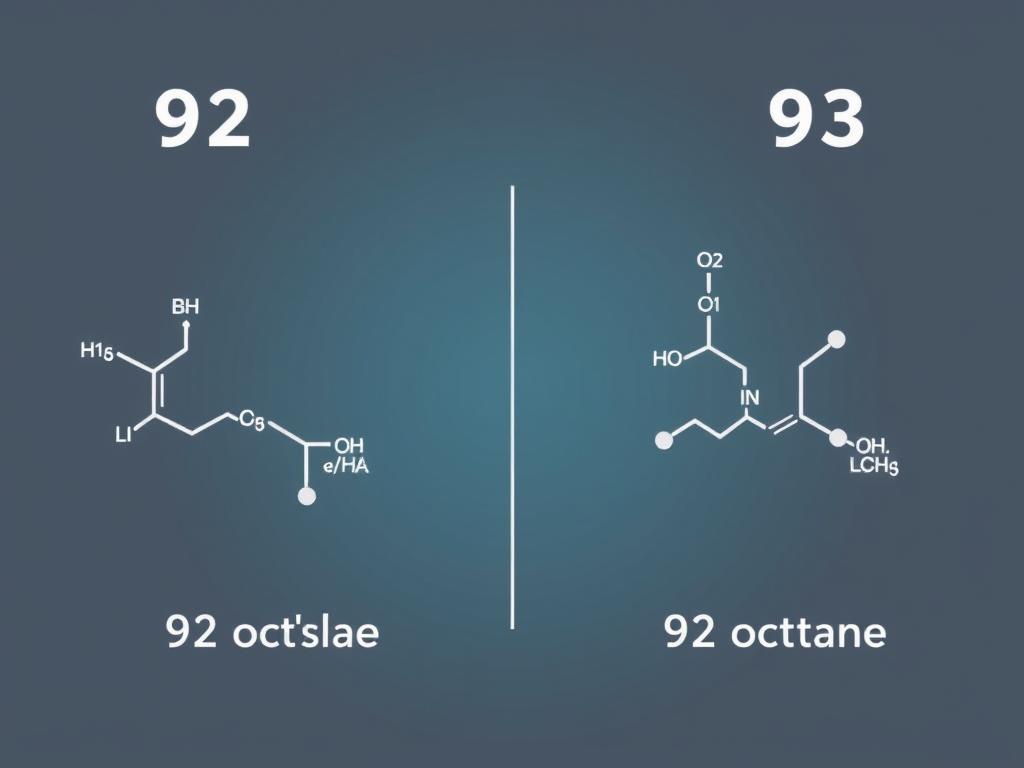
The difference between 92 and 93 octane gas lies primarily in their chemical composition. Both are premium fuels that contain a mixture of hydrocarbons, but 93 octane typically contains a slightly higher concentration of anti-knock compounds.
92 Octane Composition
- Contains a blend of hydrocarbons with 5-12 carbon atoms
- Includes anti-knock additives like ethanol (typically 10%)
- Contains detergents to clean fuel injectors and intake valves
- May include oxygenates to promote cleaner burning
93 Octane Composition
- Similar hydrocarbon blend but with slightly different proportions
- Higher concentration of anti-knock compounds
- May contain additional detergents and friction modifiers
- Often includes more sophisticated additive packages
The one-point difference in octane rating might seem minimal, but it represents a measurable difference in the fuel’s ability to resist knock under high-pressure conditions. This resistance comes from additional anti-knock compounds and slightly different refining processes.
Important Note: Both 92 and 93 octane fuels typically contain up to 10% ethanol (E10) in most regions of the United States. Some stations offer ethanol-free premium options, which may affect performance differently.
Performance Comparison in Different Vehicle Types
Standard Engines vs. High-Performance Engines
| Engine Type | 92 Octane Performance | 93 Octane Performance | Noticeable Difference? |
| Standard (Non-Turbo) | Adequate performance, no issues | Minimal improvement, not cost-effective | No |
| Turbocharged/Supercharged | Good performance, possible minor timing adjustments | Optimal performance, full timing advance | Slight |
| High-Compression (10:1+) | Adequate, possible minor knock under load | Better protection against knock | Potentially |
| Performance Tuned | May cause knock detection and timing pullback | Optimal for performance tunes | Yes |
Modern vehicles equipped with knock sensors can adjust timing to accommodate slightly lower octane fuel. When using 92 instead of the recommended 93 octane, these sensors detect any knock and retard ignition timing to prevent damage. This protective measure comes at a small cost to performance and efficiency.
For most daily drivers with standard engines, the performance difference between 92 and 93 octane is negligible. However, high-performance vehicles, especially those with forced induction (turbochargers or superchargers), may experience more noticeable effects:
Fuel Efficiency and Mileage Differences
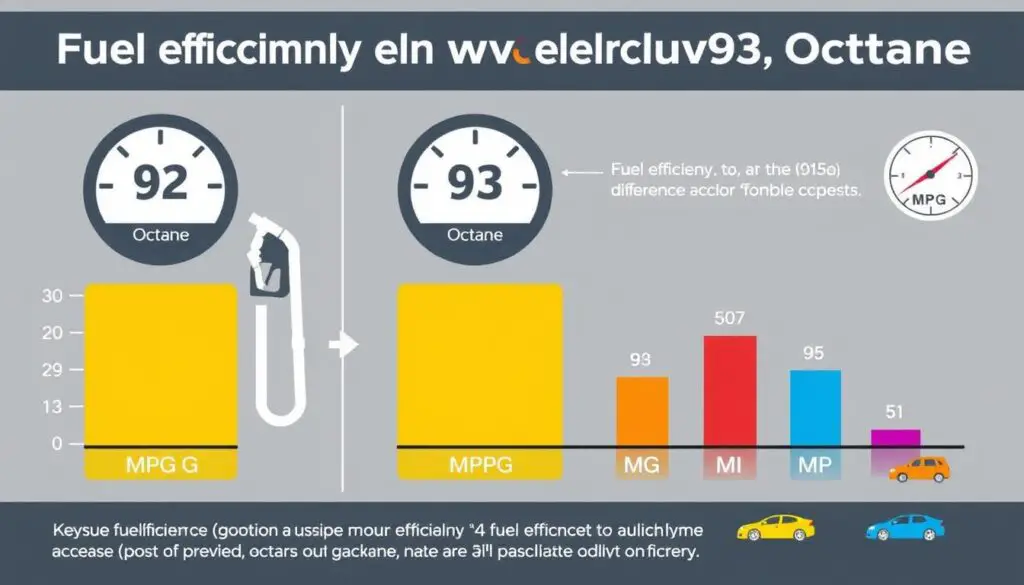
The difference in fuel efficiency between 92 and 93 octane is typically minimal for most vehicles. However, engines specifically designed for higher octane fuel may experience slightly better mileage with 93 octane due to optimized combustion timing.
93 Octane Efficiency Benefits
- Optimal timing advance in high-performance engines
- Potentially 1-2% better fuel economy in engines designed for premium fuel
- More complete combustion under high-load conditions
- Less timing retardation by knock sensors
92 Octane Efficiency Considerations
- Slight timing retardation may reduce efficiency
- Minimal impact in most modern vehicles
- Cost savings often outweigh minor efficiency loss
- Virtually indistinguishable in everyday driving conditions
In real-world testing, the fuel economy difference between 92 and 93 octane is typically less than 1% for most vehicles. This small efficiency gain rarely offsets the price premium for 93 octane unless you’re driving a high-performance vehicle specifically tuned for higher octane fuel.
Cost Comparison and Value Analysis
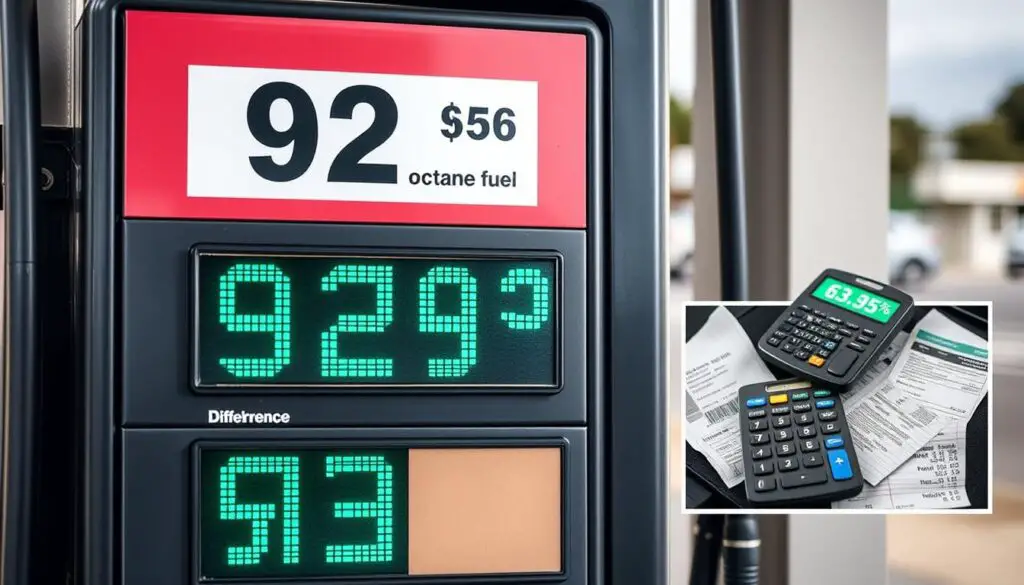
The price difference between 92 and 93 octane typically ranges from 10 to 20 cents per gallon, depending on your location. While this may seem small per fill-up, it can add up over time.
| Scenario | Annual Cost: 92 Octane | Annual Cost: 93 Octane | Annual Difference |
| 15,000 miles/year, 25 MPG | $2,160 ($4.50/gal) | $2,232 ($4.65/gal) | $72 more for 93 |
| 20,000 miles/year, 22 MPG | $4,091 ($4.50/gal) | $4,227 ($4.65/gal) | $136 more for 93 |
| 12,000 miles/year, 30 MPG | $1,800 ($4.50/gal) | $1,860 ($4.65/gal) | $60 more for 93 |
For vehicles that recommend but don’t require premium fuel, the value proposition leans toward using 92 octane in most cases. The minimal performance and efficiency gains from 93 octane rarely justify the additional cost unless you’re driving in high-stress conditions or have a performance-tuned vehicle.
Value Tip: If your vehicle requires premium fuel but doesn’t specify 93 octane, 92 octane is typically sufficient and provides better value. The money saved could be better spent on regular maintenance, which has a more significant impact on long-term performance.
Environmental Impact Considerations
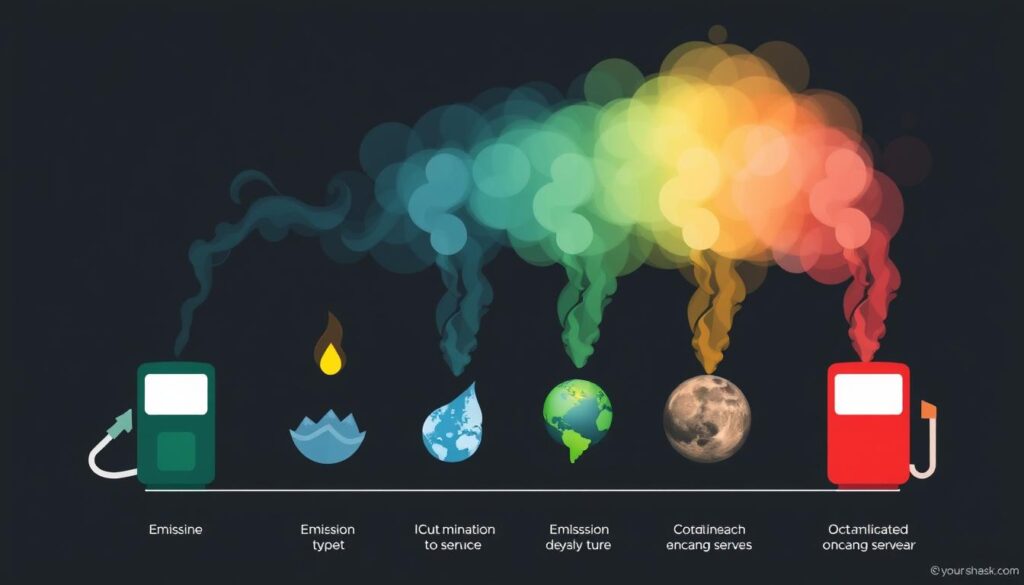
From an environmental perspective, the difference between 92 and 93 octane is minimal. Both are refined products with similar emissions profiles. However, there are some subtle differences worth noting:
- Higher octane fuels may burn slightly cleaner in engines designed for them
- The production process for higher octane fuel typically requires more energy
- Engines running on the correct octane rating produce fewer emissions than those experiencing knock
- Ethanol content (typically 10% in both grades) has a more significant environmental impact than the octane difference
Modern vehicles with catalytic converters and advanced emission systems effectively manage pollutants regardless of whether you use 92 or 93 octane, as long as the fuel meets the minimum octane requirement for your engine.
Manufacturer Recommendations and Warranty Implications
Manufacturer fuel recommendations fall into two categories: “Required” and “Recommended.” This distinction is crucial for warranty considerations:
Required Premium Fuel
If your vehicle requires premium fuel (typically 91+ octane), using lower octane could potentially void your warranty if engine damage occurs as a result. In this case, using 92 instead of 93 is generally acceptable as long as 92 meets the minimum requirement.
Recommended Premium Fuel
If premium fuel is only recommended, using 92 instead of 93 (or even regular 87 octane in many cases) won’t affect your warranty. Performance may be slightly reduced, but no damage will occur as the engine is designed to adapt.
Geographic Availability Variations
Fuel octane availability varies significantly by region in the United States:
- East Coast/Southeast: 93 octane is commonly available as the premium option
- Midwest/Rocky Mountains: 91-92 octane is typically the highest available
- West Coast: 91 octane is standard for premium in California and many western states
- Alaska/High Altitude Regions: Often limited to 90-91 octane due to different air pressure conditions
This regional variation is due to different state regulations, refinery capabilities, and altitude considerations. At higher elevations, engines naturally experience less knock due to lower air pressure, so slightly lower octane ratings are often sufficient.
Travel Advisory: If you’re traveling between regions with a high-performance vehicle that requires premium fuel, be aware that the highest available octane may vary. In areas where your required octane isn’t available, consider using a fuel additive designed to boost octane rating.
Practical Advice for Consumers
When deciding between 92 and 93 octane gas, consider these practical guidelines:
What if my car requires premium but I can only find 92 octane?
If your vehicle requires premium fuel (91+ octane) and 92 is the highest available, it’s perfectly fine to use 92 octane. Modern engines with knock sensors will adjust timing appropriately, and the one-point difference is minimal. In areas where only 91 octane is available (like California), manufacturers design their vehicles to run properly on the regionally available premium fuel.
Is it worth paying extra for 93 over 92 octane?
For most drivers, the performance difference between 92 and 93 octane doesn’t justify the price premium. However, if you have a high-performance or heavily modified vehicle, the extra octane point may provide noticeable benefits under high-load conditions. Consider your driving style and vehicle specifications when making this decision.
Can I mix 92 and 93 octane gas?
Yes, you can safely mix 92 and 93 octane fuels. The resulting octane rating will be somewhere between the two, depending on the proportions. This can be a practical approach when traveling between regions with different fuel availability.
What about ethanol content in different octane fuels?
Both 92 and 93 octane typically contain up to 10% ethanol (E10) unless specifically labeled as ethanol-free. The ethanol content has a more significant impact on fuel system components and long-term storage than the one-point octane difference. For vehicles sensitive to ethanol or for equipment that will be stored (boats, classic cars, etc.), consider ethanol-free options regardless of octane rating.
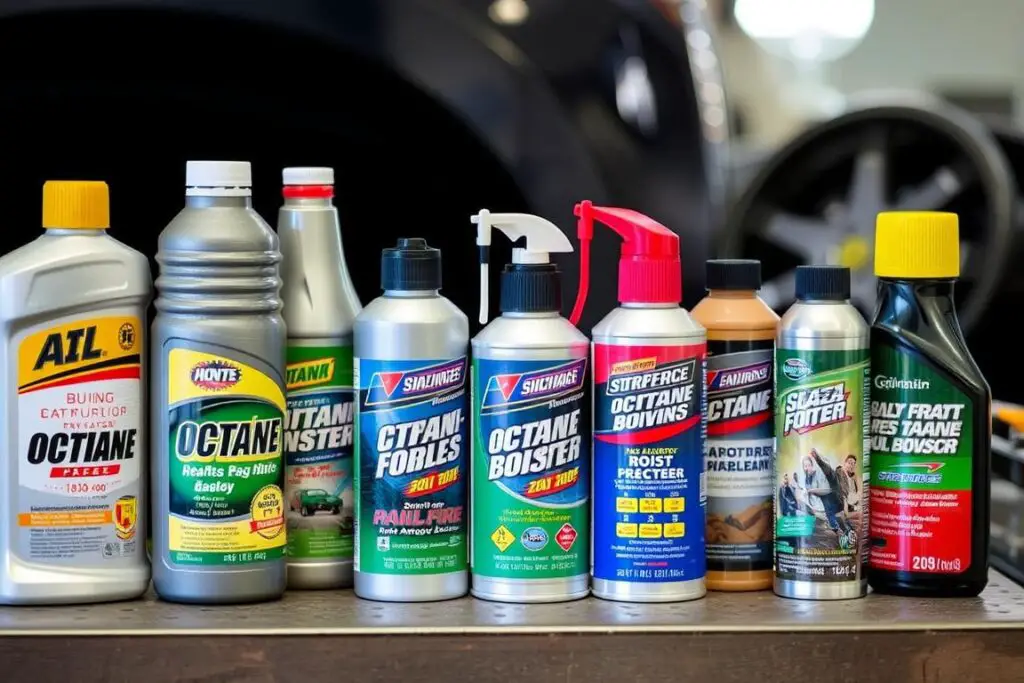
Common Myths and Misconceptions
Myth: Higher Octane = More Power
Many believe higher octane fuel contains more energy, but octane ratings only indicate knock resistance, not energy content. Using higher octane than required won’t increase power in engines designed for lower octane.
Myth: Premium Fuel Cleans Your Engine
All fuel grades contain detergent additives as required by EPA regulations. While premium fuels may contain more additives, the difference between 92 and 93 octane in cleaning ability is minimal.
Myth: One-Point Difference Is Meaningless
While small, the difference between 92 and 93 octane can matter in high-compression or forced induction engines, especially under high load or hot conditions. The importance depends on your specific engine design.
Conclusion: Making the Right Choice for Your Vehicle
The difference between 92 and 93 octane gas is relatively small but can be significant depending on your vehicle type and driving conditions. For most standard vehicles, 92 octane provides sufficient knock resistance and offers better value. High-performance vehicles, especially those with forced induction or high compression ratios, may benefit more from 93 octane, particularly under demanding conditions.
Always follow your manufacturer’s minimum octane recommendation to protect your engine and warranty. If your vehicle requires premium fuel and you’re in an area where only 92 octane is available, rest assured that this is typically sufficient, as modern engines can adapt to slight variations in fuel octane.
Remember that factors like ethanol content, fuel quality, and proper maintenance often have a more significant impact on your vehicle’s performance and longevity than the one-point difference between 92 and 93 octane. Focus on consistent use of quality fuel that meets your vehicle’s minimum requirements, and you’ll enjoy reliable performance for years to come.


